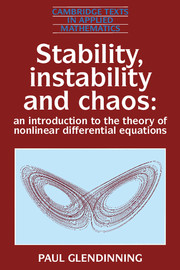Book contents
- Frontmatter
- Contents
- Preface
- Notation
- 1 INTRODUCTION
- 2 STABILITY
- 3 LINEAR DIFFERENTIAL EQUATIONS
- 4 LINEARIZATION AND HYPERBOLICITY
- 5 TWO DIMENSIONAL DYNAMICS
- 6 PERIODIC ORBITS
- 7 PERTURBATION THEORY
- 8 BIFURCATION THEORY I: STATIONARY POINTS
- 9 BIFURCATION THEORY II: PERIODIC ORBITS AND MAPS
- 10 BIFURCATIONAL MISCELLANY
- 11 CHAOS
- 12 GLOBAL BIFURCATION THEORY
- Notes and further reading
- Bibliography
- Index
1 - INTRODUCTION
Published online by Cambridge University Press: 05 June 2012
- Frontmatter
- Contents
- Preface
- Notation
- 1 INTRODUCTION
- 2 STABILITY
- 3 LINEAR DIFFERENTIAL EQUATIONS
- 4 LINEARIZATION AND HYPERBOLICITY
- 5 TWO DIMENSIONAL DYNAMICS
- 6 PERIODIC ORBITS
- 7 PERTURBATION THEORY
- 8 BIFURCATION THEORY I: STATIONARY POINTS
- 9 BIFURCATION THEORY II: PERIODIC ORBITS AND MAPS
- 10 BIFURCATIONAL MISCELLANY
- 11 CHAOS
- 12 GLOBAL BIFURCATION THEORY
- Notes and further reading
- Bibliography
- Index
Summary
Differential equations are used throughout the sciences to model dynamic processes. They provide the most simple models of any phenomenon in which one or more variables depend continuously on time without any random influences. They are also fascinating mathematical objects in their own right. If a differential equation is derived from some physical situation it is clearly desirable to know something about solutions to the equation. Indeed, there is little point deriving a model if it is then impossible to gain any information from it! This poses a big problem. Whilst most differential equations in university courses have closed form solutions, typical nonlinear differential equations do not have solutions which can be written down in terms of familiar special functions such as sines and cosines. This means that when faced with general (nonlinear) differential equations we need to change our approach. We will rarely solve differential equations, instead we will try to obtain qualitative information about the long term, or asymptotic, behaviour of solutions: are they periodic? eventually periodic? attracting? and so on. This shift from the quantitative to the qualitative is reflected in a shift in the mathematical techniques which are used to analyse equations: much of the analysis will be geometric rather than analytic.
Initially we will concentrate on hyperbolic solutions. Roughly speaking a solution is hyperbolic if all sufficiently small perturbations of the defining differential equation have similar behaviour close to that solution (this is not simply a statement about continuity).
- Type
- Chapter
- Information
- Stability, Instability and ChaosAn Introduction to the Theory of Nonlinear Differential Equations, pp. 1 - 24Publisher: Cambridge University PressPrint publication year: 1994
- 1
- Cited by



